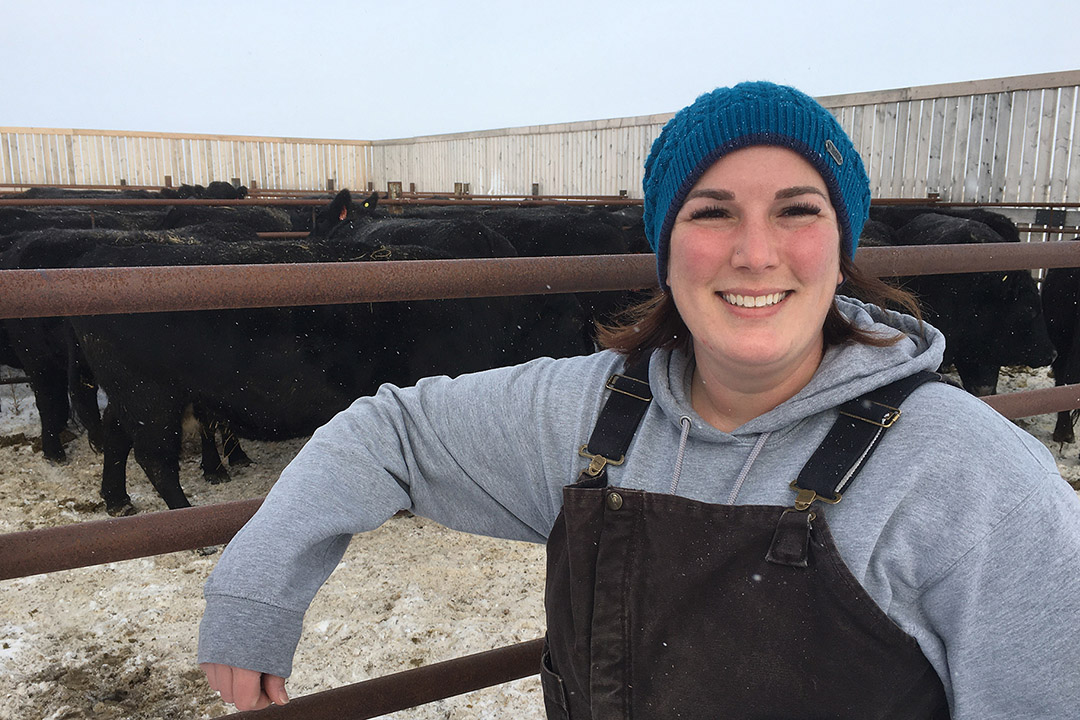
Texas student weathers winter research conditions
Feeding cattle in the winter is a much different experience in Saskatchewan than it is in Texas. It may seem obvious but it’s still full of surprises for a University of Saskatchewan (USask) graduate student.
By Lana Haight“I’m continually impressed with how innovative you Canadians are and how you manage winter,” said Rachel Carey, a PhD provisional candidate who is co-supervised by USask animal scientist Dr. Greg Penner (PhD) and Agriculture and Agri-Food Canada researcher Dr. Tim McAllister (PhD).
Carey was surprised when she learned about a potential research project that she is now running. She is monitoring the body condition of pregnant cows, including their weight gain and fat cover, as the cows graze in fields in the fall and winter for as long as conditions are suitable for the cattle, and that includes fields even when there is snow on the ground.
“This is my first winter grazing study ever! I thought Canadians were crazy when I first heard about winter grazing. I had no idea this was even happening.”
Carey, who grew up in a small city in Texas, has taken a long and winding road to Saskatoon. After teaching high school in Texas for five years, she went back to school to pursue veterinary college but after taking a course in ruminant nutrition at New Mexico State University, she switched gears and enrolled in a master’s program in animal science instead.
From there, she worked three years with a feedlot consulting company based in Calgary. When she decided to return to school for a PhD, she knew she wanted to be at USask and supervised by Penner, having read research papers by him when she was a master’s student.
Grazing bred cows in fields during the winter is not new in Western Canada, but no research has been conducted on how well animals fare when they graze on corn residue—the leaves, stalks, husks, cobs, everything that’s left in the field after the high-moisture corn kernels have been harvested.
“Profit margins for farmers and cattle feeders are extremely tight. Anything they can do to decrease the cost of feeding animals while maintaining (growth) performance is important. We are looking at the possible economic benefits of using these alternative corn products.”
Carey’s research is addressing the old adage “waste not, want not” with her whole-systems study.
In the spring of 2020, 200 acres of corn was seeded at the university’s Livestock and Forage Centre of Excellence, south of Clavet, Sask. The corn was harvested as three different products: as snaplage, the term used to describe a method where the ear of the corn is harvested or what would be snapped off the corn stalk, as high-moisture corn and as corn silage. In all three cases, the feed was fermented and, starting in February, the corn has been fed to two groups of cattle at the centre’s feedlot and in its metabolism barn.
Carey is tracking the animals’ weight gain and evaluating how well the animals are digesting the corn feed.
She started the bred cow component of her research on Nov. 25 when 30 cows began feeding on the high-moisture corn residue left in windrows. Another 30 were in a control group, feeding on barley that was swathed at the hard dough stage.
“These are good Canadian cattle. They know what they are looking for. They have figured it out,” said Carey. “Once you have the cows trained to look for the swaths and nose around in the snow, they find the feed. I was amazed at how fast they found the swaths. They knew exactly where they were.”
Carey wasn’t able to feed cows using the snaplage residue because a winter storm in early November covered the snaplage residue with snow too deep for the cattle to find the feed.
Carey’s project took another hit with freezing rain and heavy, wet snow in early January. She and Penner made the difficult decision to move all the bred cows off the fields and to the centre’s Forage and Cow-Calf Research and Teaching Unit where they are continuing to be fed.
As disappointed as she is, Carey realizes that she is conducting real-world research with real-world conditions, the same unpredictable weather conditions cattle farmers in Western Canada face every year.
“It’s hard to compete with Mother Nature,” said Carey with a laugh.
The research is funded by Saskatchewan Cattleman’s Association and Beef Cattle Research Council and the seed is provided by Pioneer Hi-Bred. Carey’s research will continue until the summer of 2022.

